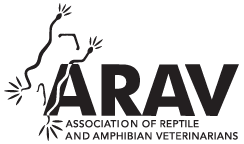A Unique Disease Presentation Associated with a Mesomycetozoean-Like Organism in the Jeweled Chameleon (Furcifer campani)
Recent evidence suggests that lizards of the family Chamaeleonidae are one of the most heavily parasitized groups of reptiles kept in captivity; however, little is known about the clinical implications of these infections. Relative to other host species, there is a paucity of information on reptile parasites and the breadth of parasites that infect chameleons is not well described. We report a parasitic infection most consistent with organisms belonging to the Mesomycetozoea group in male and female wild-caught jeweled chameleons (Furcifer campani). Clinical features of infection included persistent weight loss, despite increased food intake; cachexia; abnormally increased light- and heat-seeking behavior; coelomic distention; and loose, watery stools. Histologically, there was extensive granuloma formation present in the liver and widespread localization of periodic acid–Schiff- and Grocott's methenamine silver–positive spores resembling those of Dermocystidium sp. in the bone marrow, gastrointestinal tract, and other tissues. A second case of infection with this pathogen also presented with concurrent Mycobacterium sp. throughout the body, suggesting that infection with mesomycetozoean organisms may serve as a primary cause of death, or conversely, may render the infected individual susceptible to secondary, opportunistic infection. The rapid health decline associated with infection in these cases indicates a need to better characterize prevalence and pathogenicity of parasites in captive chameleons.Abstract

Jeweled chameleon (Furcifer campani) appearance. (A) Healthy male showing characteristic coloration, normal muscle tone, and normal fat pad content. (B) An individual (case 2) infected with a with a Dermocystidium-like organism, showing lightened skin color with dark patch on abdomen, slightly sunken-in eyes, cachexia, and loss of fat pads on cheek and casque.

Histological images of H&E-stained liver and gastrointestinal (GI) tract sections of jeweled chameleons (Furcifer campani) infected with a Dermocystidium-like organism. (A) Liver parenchyma with granuloma (blue arrow). (B) Liver parenchyma with eosinophilic spores (red arrows) within macrophages and vessels. H&E stain. (C) GI tract showing periodic acid–Schiff (PAS)-positive spores. PAS stain. (D) Spores in the GI tract. Grocott's methenamine silver stain.



